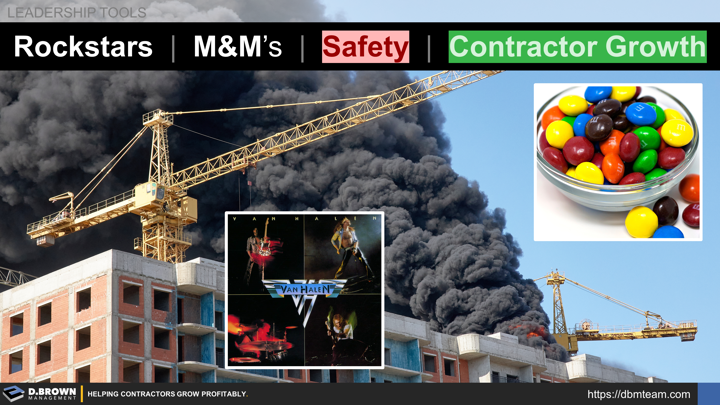You know what should be done and how.
You have set your standards and communicated them clearly.
How do you make sure that they are being followed consistently without double-checking or double-doing everything?
That is the critical question that managers and leaders at all levels must answer as they are accountable for the outcomes of others.
Some of those accountabilities are relatively minor in the grand scheme of things.
Others are major safety, financial, and reputational risks. A handful of those accountabilities may be life or company ending. That is the weight of responsibility carried by many in the construction industry.
Identify simple indicators that are proxies for potentially deeper problems.
For David Lee Roth, this was the "Brown M&M Clause" buried deep in their exceptionally detailed contract rider. This contract rider was basically the equivalent of the plans and specifications on a construction project. It spelled out in great detail the requirements for power, safety, and structural requirements at the venue. Van Halen was bringing a much more sophisticated set up than what most venues were used to, including pyrotechnics, acrobatics, and extremely heavy equipment.
Van Halen was bringing nine semi-trucks of equipment when other acts were bringing a max of three at the time, and they had to do this set up every day in a new city leveraging a workforce that they had never worked with before. This is no different than many of the large projects being built in the midst of a major talent shortage.
The band members themselves were the ones at the greatest safety risk if things were not setup correctly.
The Process: The brown M&M clause buried deep in the middle of the 53-page contract rider from 1982.
The contract clause basically stated that there will be no brown M&M's in the backstage area and if there were, Van Halen would not perform and be paid-in-full.
This was seen as a frivolous and ego-driven rockstar request. The reality was that it was a much more intentional quality control (QC) check that triggered a complete deep-dive inspection. Contractors can leverage this principle and similar tactic to manage the myriad of changes that take place with growth.
Think about those damages like exceptionally high liquidated damages in a construction contract. When damages are in the $1M per day range, projects tend to finish on time, every time. The contractor pays attention to the schedule with every decision made.
David Lee Roth knew that if he went backstage and found any brown M&M's then it was obvious that the promoter and their team did not pay attention to the contract in detail. It didn't trigger them to leave the venue which would have angered fans and been a reputational risk.
What it did trigger was a much deeper inspection by their team of the entire production setup which inevitably turned up other technical problems including safety risks.
Dan and Chip Heath summarize this process in Decisive - How to Make Better Decisions in Life and Work.
David Lee Roth has explained it in more detail in his book and various interviews including this short excerpt below.
How does this principle and tactic apply to the management of a construction business?
Recruiting: Defining a handful of "Knockout Questions" by role that can be used during the screening process to rapidly eliminate candidates that have a low probability of making it through the more intensive deeper-dive interview and testing process. Once you get beyond the simple ones like certifications or criminal records, most knockout questions are technical related to the role. They are simple enough where anyone competent in the role should have quick, accurate, and nuanced answers with examples. An example might be the calculation of concrete order for a footing of a certain size.
Managing PMs: Schedule management is a critical Project Manager responsibility heavily tied to customer satisfaction and profitability. This is a complex and nuanced process involving multiple different tools and communication. A manager who is accountable for multiple Project Managers won't ever be able to get into all those details. A simple set of checks may start with:
- Is there a current project master CPM schedule in the project files? Poor document control doesn't mean poor schedule management, but it is an indication of needing to dive deeper.
- Is there a current short-interval plan (SIP) schedule in the project files and does it align roughly with the current master schedule?
These two quick checks are not perfect indicators about how the schedule is being managed. They are a good indicator that you should dive deeper in scheduling with that PM on that project.
What are a few "Knockout Questions" you could ask about the schedule that would give you an indication on whether you should continue diving in more deeply or satisfy you that this was just a document control hiccup?
What you want to look for and build into your management system are things like this at all levels. They won't guarantee 100% perfect outcomes every time, but they will start stacking the deck more in that direction.

